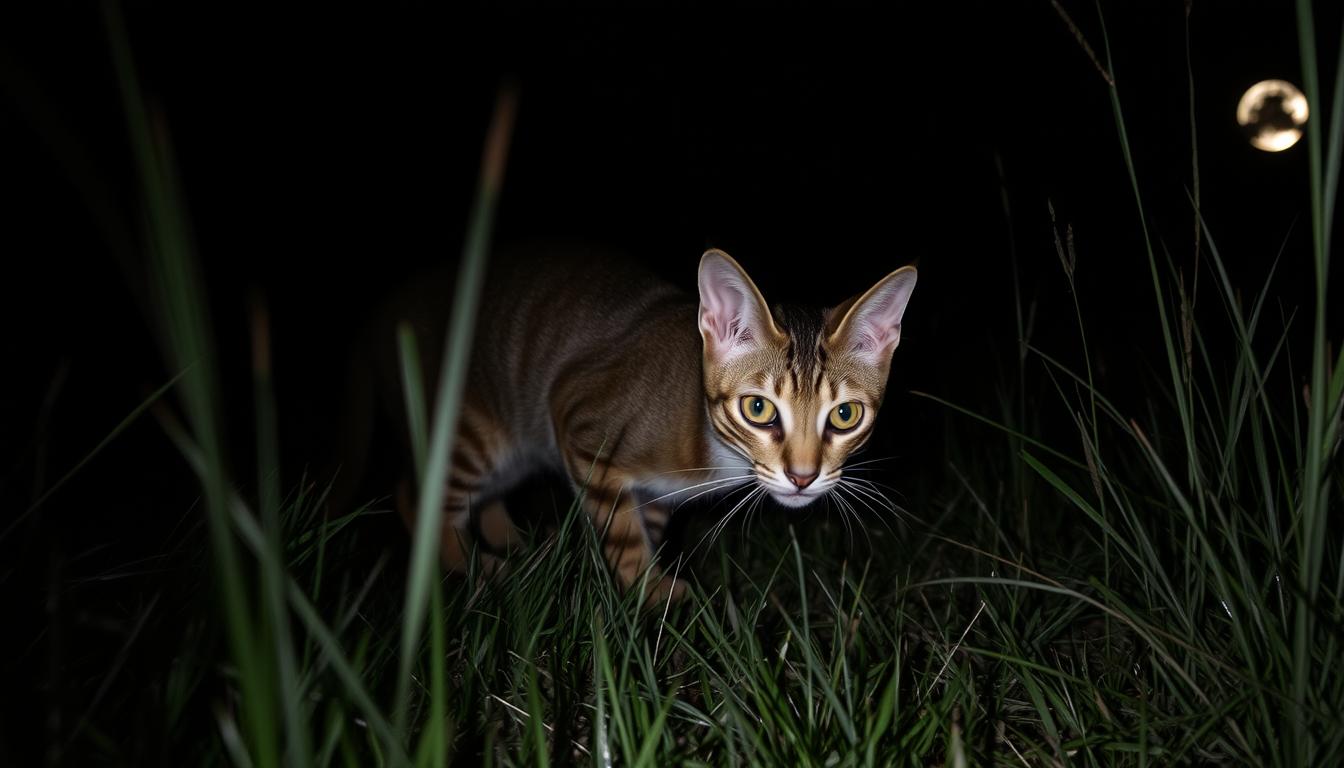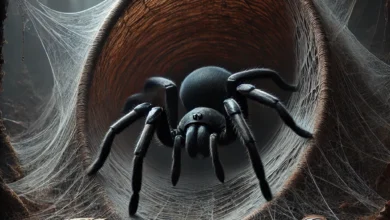Can Cats See in The Dark? Amazing Night Vision Facts

Can Cats See in The Dark? Amazing Night Vision Facts
Cats are known for their night vision, but it’s not as simple as it seems. They can’t see in complete darkness1. They need much less light than humans to see well in the dark1. Their eyes can see 200 degrees around them, giving them better peripheral vision1.
The tapetum in their eyes helps them catch more light1. This makes their night vision amazing.
Cats are most active at dawn and dusk. Their eyes are made for these times, adapting to light better than humans1. They can’t see far away clearly, but they’re great at noticing small movements1. They see the world in shades of blue and green, not as vividly as humans1.
Key Takeaways
- Cats require significantly less light than humans to see in low-light conditions.
- Cats have a wider field of vision and better peripheral vision than humans.
- The unique anatomy of cats’ eyes, including the tapetum, allows them to receive more light and adapt to a wider range of light levels.
- Cats are near-sighted and excel at detecting subtle movements and changes in light.
- Cats see mostly in shades of blue and green, with less saturated colors compared to humans.
Understanding Feline Night Vision Capabilities
Cats can’t see in complete darkness2. But they see much better in low light than humans do. Their eyes are made for moving around in dim places.
The Truth About Cats and Complete Darkness
Cats can’t see in total darkness, but they’re great in low light2. Kittens can see well in the dark from just five weeks old2. This helps them hunt at dawn and dusk2. Cats see better in the dark than dogs do2.
How Cats Compare to Human Vision
Cats see much better at night than humans do3. They can spot things 20 feet away, but things farther off are blurry3. Their wide field of vision helps them spot movement and prey easily.
Cats also smell and hear better than humans3. They have more scent receptors and can hear sounds from far away3. These skills, along with their night vision, make them great hunters at dawn and dusk4.
“Cats are crepuscular, meaning they are most active during dawn and dusk, when their superior night vision gives them a distinct advantage over their prey.”
Can Cats See in The Dark: Myth vs Reality
Cats can’t see in complete darkness, but their night vision is amazing. They only need a little light to see, unlike humans. Their eyes are made for low light, with a wide field of vision and a special layer called the tapetum lucidum56.
Cats see better around the edges than in the middle, unlike humans. They can spot movement and shapes better56.
They have more rod cells and fewer cone cells in their eyes. This helps them see better in the dark for movement5. Their eyes also let in more light, giving them better vision in low light6.
Some cat breeds, like Abyssinian, Persian, and Himalayan, might get eye problems like PRA5. But, a Breed + Health Cat DNA Test can check for 43 genetic diseases, including these eye issues5.
In conclusion, cats can’t see in complete darkness, but their night vision is impressive. By knowing the truth about cat vision, we can appreciate how they adapt to low light7.
The Fascinating Anatomy of Cat Eyes
Cats have a special eye structure that helps them see well at night. Their curved cornea and big lens collect more light8. The tapetum lucidum, a layer behind the retina, reflects light back to the cells. This makes their night vision even better9.
Rods and Cones in Cat Eyes
Cat eyes have mostly rods, making up 96% of their retina9. Rods are great at picking up light and movement. This helps cats track prey and move around in the dark8. But, cats see colors less well because they have fewer cones10.
The Role of the Cornea and Lens
Cats’ eyes are designed to catch more light. Their curved cornea and big lens help them see better in the dark8. This lets them move and catch prey with great skill, even when it’s very dark.
Understanding the Tapetum Lucidum
The tapetum lucidum is a special layer in cat eyes9. It reflects light back to the retina. This doubles the light reaching the retina, making their night vision better9. Cats with a stronger tapetum lucidum can see even better in the dark8.
The unique anatomy of cat eyes, including their cornea, lens, and tapetum lucidum, helps them hunt at night. Their high rod-to-cone ratio also plays a big role in their night vision skills8910.
The Secret Behind Cats’ Glowing Eyes
Ever seen a cat’s eyes glow in the dark? It’s not just a trick. It’s because of a special part called the cat tapetum lucidum11.
The tapetum lucidum is a special layer in cats’ eyes. It’s like a mirror that reflects light back to the retina. This lets the eyes catch more light at night11.
Humans don’t have this layer. So, when light hits their eyes at night, it just goes through. Their eyes look dark11.
Cats’ eyes are amazing at night because of this layer. They have seven times more rods than humans. This helps them see better in the dark12.
This special layer and the many rods make cats’ eyes glow. The glow can look green-silver or even reddish, especially in cats with blue eyes11.
But, humans don’t glow like cats. The “red-eye” in photos comes from light reflecting off blood vessels in the retina. It’s not the same as a cat’s tapetum lucidum11.
The tapetum lucidum is what makes cats’ night vision so good. It lets them move around easily even when it’s dark1112.
How Cat Pupils Adapt to Light Changes
Cats have a special way to adjust their pupils to different light levels. In bright light, their pupils narrow into a vertical slit. This helps them focus and limits the light that enters their eyes13. When it gets darker, their pupils open wide, becoming a full circle. This lets them control how much light they get and improves their night vision.
Vertical Slit to Full Circle Transformation
Cats’ pupils change from a vertical slit to a full circle. This is a unique feature of their anatomy. While humans’ pupils can only get 15 times bigger, a cat’s can grow up to 135 to 300 times larger13. This makes them very good at seeing in the dark.
Light Sensitivity and Adaptation
Cats are very sensitive to light. They have more rod photoreceptors in their retina than humans do14. This helps them see in the dark, making them great hunters at night. Kittens are born without sight, but their eyes are fully developed by six weeks old14.
But cats can’t see colors as well as humans. They have fewer cone-shaped photoreceptors, seeing mainly blue, yellow, and grey13.
Cats’ amazing ability to adapt to light, combined with their night vision and motion detection, makes them excellent hunters. They can move and see well in low light, helping them survive and thrive1415.
Color Vision and Depth Perception in Cats
Cats see the world differently than humans. They don’t see colors as vividly, but their vision is perfect for hunting at night16.
Cats can’t see red and green well, seeing mostly blue and yellow17. They have fewer cone cells than humans, making it hard to see color changes17. But, they have more rod cells, helping them see better in the dark16.
Cats see more around them than humans, with a 200-degree field of vision18. But, they can’t judge distances like humans do, because their eyes are on the sides of their head17. This makes things seem clear only up to 20 feet away17.
Despite these differences, cats are very good at seeing in the dark. Their pupils get really big, letting in more light16. They also have a special layer in their eyes that helps them see better in the dark16.
Knowing how cats see can help us understand them better. It shows how cats have adapted to be great hunters and pets.
In short, cats see the world in their own special way. Their vision is perfect for hunting at night. By understanding their vision, we can appreciate their amazing abilities.
Cat Vision During Dawn and Dusk
Cats are most active at dawn and dusk, known as twilight hours19. Their eyes are made to see well in these dim conditions. This makes dawn and dusk perfect for hunting and exploring.
Domestic cats often get more active during these times. They might wake their owners or play more10.
Crepuscular Nature of Cats
Cats can see 200 degrees around them, more than humans’ 180 degrees1910. This wide view helps them spot movement better in twilight. Their eyes also have fewer cones and more rods, making them see better in the dark19.
Peak Hunting Hours
Cats can see in light levels six times lower than people19. This amazing night vision makes dawn and dusk the best times for hunting. Their vertical slit-like pupils adjust to light changes, helping them see well in these hours10.
Indoor cats can still enjoy activities like window perches and cat trees. These help them follow their natural crepuscular behavior patterns19.
“Cats can see six times better than an average human in an environment with limited light, according to National Geographic.”10
| Feature | Cats | Humans |
|---|---|---|
| Field of View | 200 degrees | 180 degrees |
| Light Sensitivity | 6 times better | Average |
| Cones (for color vision) | Fewer | 10 times more |
| Rods (for low-light vision) | More | Less |
| Eyesight Development | Fully developed at 5 weeks | Develops gradually |
Cats’ Superior Motion Detection
Cats are amazing at spotting movement, a skill that helps them hunt well20. Their eyes can catch even the smallest changes, making it easy to track fast prey or toys. This is because they have lots of rod cells in their eyes, helping them see small movements and changes in light20.
Unlike humans, cats can see almost all around them, about 200 degrees21. This wide view, combined with their great motion detection, helps them find food or threats. They also need less light to see movement, which is great in dark places20.
Even though cats don’t see colors as well as humans or see things far away, they can track movement like no other21. This skill is a result of their evolution. It helps them hunt and stay safe, making them very aware of their surroundings.
In short, cats’ amazing ability to detect motion is key to their hunting and survival2021. They use this skill to move around, find food, and quickly respond to dangers. This makes them top predators in the animal world2021.
Conclusion
Cats can’t see in complete darkness, but their eyes are great for feline night vision. They have special features like the tapetum lucidum and adaptable pupils. These help them see better in the dark than humans22.
They can spot things six times better than us at night. Their eyes have lots of rods, which are super sensitive to light22. This makes them great hunters and explains why they’re active at night22.
Knowing about cat eye adaptations helps us see how special our feline friends are.
Cats can gather more light because their lens and cornea are bigger compared to their eye size23. This helps them see better in the dark. The tapetum lucidum also helps by reflecting light back through the retina23.
Also, cats have a wider field of view than us. This is because of how their eyes are placed and the shape of their eye sockets23.
In short, while cats can’t see in total darkness, they’re really good at seeing in low light. Learning about feline night vision helps us appreciate our feline friends even more.
FAQ
Can cats see in complete darkness?
No, cats can’t see in total darkness. But they see much better than humans in dim light.
How do cats’ eyes compare to human eyes in terms of low-light vision?
Cats need much less light to see than humans. They have more rods in their eyes. Their pupils also open wider, catching more light in dark places.
What adaptations allow cats to see so well in low light?
Cats have a curved cornea and large lens. They also have a reflective layer called the tapetum lucidum. These help gather and reflect light, improving their vision in the dark.
What causes the glowing effect in cats’ eyes?
The glowing effect comes from the tapetum lucidum. This layer reflects light back to the retina. It gives them a second chance to absorb light.
How do cats’ pupils change to adapt to different light levels?
Cats’ pupils change shape with the light. In bright light, they are narrow. In low light, they open wide. This helps them adjust to different light levels.
What are the differences between cats’ and humans’ color vision and depth perception?
Cats see the world in shades of blue and yellow, not red and green. They have a wider field of vision but less sharp middle vision. They are also near-sighted compared to humans.
When are cats most active, and how does their vision help them during those times?
Cats are most active at twilight. Their eyes are perfect for seeing in these low-light hours. It’s ideal for hunting and exploring.
How do cats’ motion detection capabilities contribute to their hunting abilities?
Cats can spot movement well, thanks to their many rod cells. This helps them catch quick prey by detecting even slight changes in light and movement.



